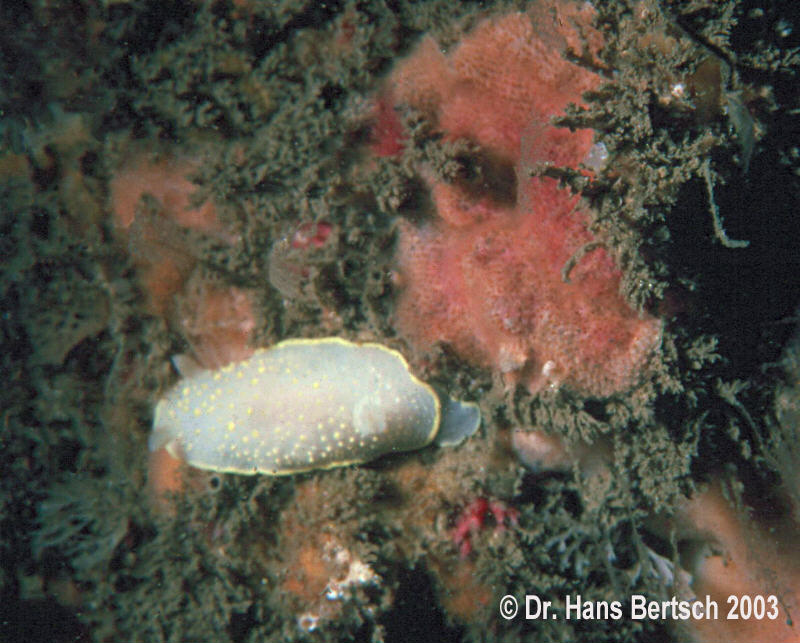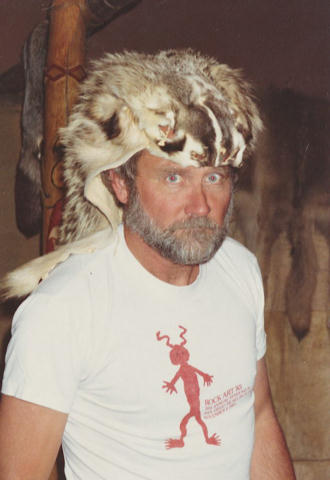 |
Cadlina luteomarginata
Photo courtesy of Dr. Hans Bertsch
Cadlina luteomarginata MacFarland, 1966
Comprehensive discussions on this species have appeared on Bill Rudman's Sea Slug Forum. However, to complete the SlugSite's presentation of the cadlinids from the Pacific coast of the Americas, I herewith present a few more photos and scanning electron micrographs of this species to aid in additional comparisons by my colleagues (especially Rebecca Johnson who is actively working on the cadlinids and chromodorids). Cadlina luarna was recently treated ably by Ángel Valdés and Orso Angulo Campillo so I will not repeat that species.
Cadlina luteomarginata was twice named by MacFarland: in 1905 as Cadlina marginata , and then in 1966 as Cadlina luteomarginata, because he interpreted the ICZN rules of priority and synonymy that his original name had previously been used in this genus by Doris marginata Montagu, 1804, which is a junior synonym of Cadlina laevis (Linnaeus, 1767). Rather than making decisions on his statements, it is best to use the name C. luteomarginata until substantive evidence to the contrary is presented.
This species' distribution is from Lynn Canal, Alaska, to Punta Eugenia, Baja California Sur, Mexico (Behrens, 1991). Dave Behrens comments that it occurs from the intertidal to 45 m deep, and feeds on the sponges Halichrondra, Myxilla , and Higginsia . Jeff Goddard (in Sea Slug Forum) states that it also feeds on the sponge Pleraplysilla sp.
McDonald (1983: 154) describes the radular formulae based on his and MacFarland's records: "Radular formula of specimen examined 89 (57-63.1.57-63), MacFarland (1966: 142) reports 90-114 (47-58.1.47-58). Rachidian teeth bear 4-7 denticles. Inner laterals hooked and bear 4-14 denticles." Behrens (1991) succinctly states, radula 89-90 x 47-63.1.47.63. Both need to be incorporated into the radular variation of this species and correlated with the sizes of the living animals (Bertsch, 1976).
Attached are scanning electron micrographs of the radula of a specimen collected by Charlie Spowarth for the University of California Berkeley zoology department in February 1974, from the Monterey area. The first image shows the central portion of the radula ; on a 35 mm slide the magnification is 100x. A close-up of the rachidian teeth shows the denticles on the rachidian . An overall view of teeth from the middle of the half-row shows the erect cusp and denticles . This scanning electron micrograph is an extreme close-up of these central teeth from the middle of a half-row; the denticles are clearly visible. The outermost teeth are greatly reduced in size, as is typical. This SEM emphasizes the shape of the outermost teeth. Again, on a 35 mm slide the magnification of this image is 333x. This final SEM illustrates the jaw platelets are magnified on a 35 mm slide to 1000x.
Well, Cadlina luteomarginata is a beautifully distinctive cadlinid. "Its translucent white dorsum is edged by a yellow line, and [it] has low tubercles which are tipped with yellow. The gills, made up of six branchial plumes, are tipped with yellow" (Behrens, 1991: 57).
Happy hunting, and we need lots of information about the distribution (geographic, temporal and bathymetric) regarding these species. Please let me know your findings!
Selected References
Behrens, David W. 1991. Pacific coast nudibranchs. Second edition. Sea Challengers,
Monterey, 107 pp.
Bertsch, Hans. 1976. Intraspecific and ontogenetic radular variation in opithobranch systematics (Mollusca: Gastropoda). Systematic Zoology 25 (2): 117-122.
MacFarland, Frank Mace. 1966. Studies of opisthobranchiate mollusks of the Pacific coast of North America. California Academy of Sciences Memoirs 6: 1-546.
McDonald, Gary R. A review of the nudibranchs of the California coast. Malacologia 24 (1-2): 114-276.
192 Imperial Beach Blvd. #A
Imperial Beach, Calif
Jun. 2003
Taxonomic Information and Photos Courtesy of Dr. Hans Bertsch
College of Oceaneering, 3580 Aero Court, San Diego, CA 92123

You can drop Hans a note at hansmarvida@cox.net
|
